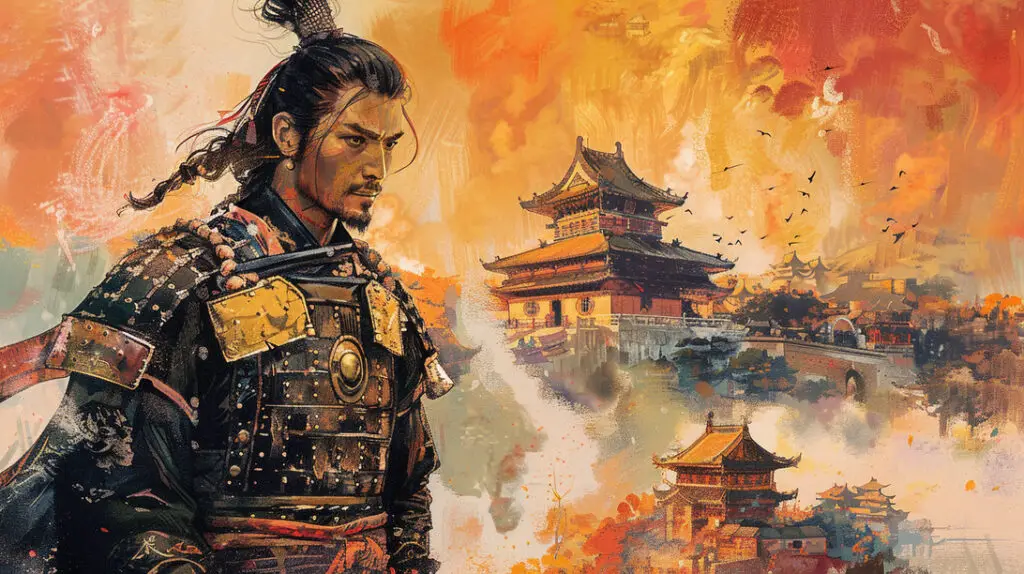“Shogun,” the novel by James Clavell, first published in 1975, is an epic historical fiction set in early 17th-century Japan, part of Clavell’s Asian Saga. The novel immerses readers in a richly detailed narrative that explores the complex political, cultural, and personal landscapes of feudal Japan through the eyes of both Eastern and Western characters. (Get the book from Amazon – link here.)
At its heart, “Shogun” is a story of power, ambition, culture clash, and romance, centered around the arrival of an English navigator, John Blackthorne, whose ship docks on the Japanese coast, setting off a series of events that intertwine his fate with that of lords (daimyo), samurai, and the powerful and enigmatic figure known as the Shogun.
The book is divided into many chapters that detail Blackthorne’s transformation from an outsider to a key player in the intricate politics of Japan, as well as the broader shifts in power dynamics among the Japanese.
The novel opens with John Blackthorne, the pilot of the Dutch trading ship Erasmus, as he and his crew are shipwrecked on the Japanese coast near the village of Anjiro. They are the first Englishmen to set foot in Japan, and their arrival is met with curiosity and hostility in equal measure. From the onset, the cultural divide between the East and West is palpable, setting the stage for the novel’s exploration of themes like honor, loyalty, and the clash of civilizations.
Here are 10 key narrative and thematic elements of “Shogun”:
1. Arrival in Japan
Blackthorne and his crew are captured by local samurai. The Englishmen are bewildered by the customs and language of Japan, struggling to comprehend the society they have stumbled into. Blackthorne, referred to by the Japanese as “Anjin-san” (Pilot), catches the interest of Lord Toranaga, a powerful daimyo with aspirations to become Shogun, the military dictator of Japan.
READ MORE: Miyamoto Musashi – A Book of Five Rings: A Timeless Guide to Strategy and Life
2. Captivity
The crew faces the harsh realities of captivity. They witness the brutal enforcement of samurai code and are exposed to the complex social hierarchy of Japan. Blackthorne, in particular, begins to learn the Japanese language and customs, driven by a desire to survive and an innate curiosity about this alien culture.
3. Toranaga’s Interest
Lord Toranaga sees Blackthorne as a pawn in his strategic plans. Through his interactions with the daimyo and other key figures, Blackthorne gains insight into the political tensions between Toranaga and his rival, Ishido, who controls the impregnable Osaka Castle.
4. Blackthorne’s Rise
Blackthorne earns Toranaga’s trust and is granted the status of samurai, a rare honor for a foreigner. This marks the beginning of his ascent in Japanese society and his deeper involvement in the political intrigues of the land.
5. Cultural Assimilation
As Blackthorne continues to assimilate into Japanese culture, he forms a romantic relationship with Mariko, a Christian Japanese woman who becomes his interpreter and cultural guide. Through Mariko, Blackthorne gains deeper insights into the complexities of Japanese society, including the tension between Buddhism and Christianity.
6. Political Maneuvering
The novel details the intricate political maneuvering between Toranaga, his allies, and his enemies. Blackthorne finds himself increasingly caught in the middle of these power struggles, using his knowledge of Western naval tactics to influence the balance of power.
7. The Battle for Supremacy
The climax of the novel revolves around a decisive battle that determines the fate of Toranaga and his quest to become Shogun. Blackthorne plays a crucial role in the conflict, leveraging his ship and crew in a pivotal engagement.
READ MORE: James Clavell’s “Shogun” | The Ultimate Chapter Summaries
Conclusion
The novel concludes with Toranaga emerging victorious, laying the groundwork for his rule as Shogun. Blackthorne, now fully integrated into Japanese society and recognized as a key ally of Toranaga, contemplates his future in Japan, torn between his loyalty to his new home and the pull of his English identity.
“Shogun” is a sprawling narrative that offers a window into a world where honor and duty govern life and death, where cultures collide and coalesce, and where personal destinies are intertwined with the fate of nations. Through its vivid storytelling and deep historical insights, the novel not only entertains but also educates, leaving a lasting impact on its readers.




